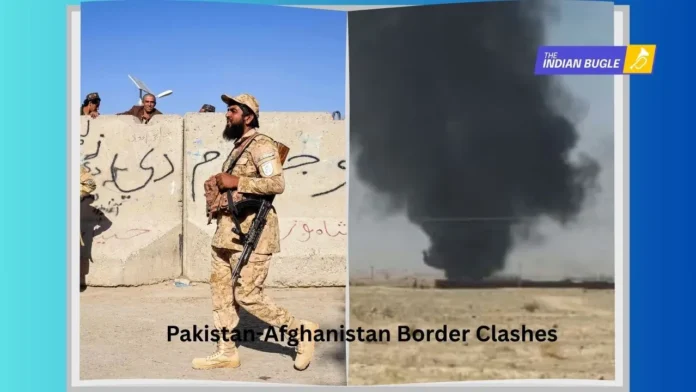In October 2025, the Pakistan-Afghanistan border once again became a flashpoint of violence, as heavy clashes erupted along the Durand Line — one of the most volatile frontiers in South Asia.
Dozens of lives were lost, including Pakistani soldiers, Afghan civilians, and even young cricketers, after intense shelling and airstrikes shook border regions like Khost, Kunar, and Chaman.
However, amid rising tensions, both sides have now agreed to peace talks in Doha, signaling a possible thaw in one of the region’s most complex and enduring rivalries.
The Root of the Conflict: The Durand Line Dispute
The Durand Line, drawn in 1893 during British colonial rule, divides the Pashtun heartland between Pakistan and Afghanistan.
For decades, Afghanistan has refused to formally recognize this 2,600 km border, while Pakistan considers it a settled international boundary.
The issue remains at the heart of recurring border clashes.
Tensions have escalated further since the Taliban’s return to power in Kabul in 2021, as both sides accuse each other of:
- Harboring militant groups (notably TTP and IS-K).
- Cross-border incursions and unprovoked firing.
- Restricting the movement of refugees and traders along the frontier.
The Recent Escalation: October 2025 Clashes
The latest outbreak of violence reportedly began after Pakistan conducted airstrikes targeting Tehrik-e-Taliban Pakistan (TTP) hideouts inside Afghan territory.
In retaliation, Afghan border forces fired across, hitting civilian areas in Pakistan’s Kurram and North Waziristan districts.
Key highlights of the conflict:
- Over 40 people were killed, including civilians and Afghan cricketers, traveling near Khost.
- Thousands were displaced from villages along both sides of the border.
- Trade routes shut down, impacting local economies.
- Taliban’s Defense Ministry accused Pakistan of violating sovereignty, while Pakistan maintained it was targeting militants responsible for deadly attacks inside its borders.
This cycle of strike and counter-strike pushed the region to the brink of a wider confrontation.
Peace Talks in Doha: A Fragile Hope
In mid-October 2025, representatives from Pakistan’s Foreign Office and the Taliban government in Kabul began peace negotiations in Doha, Qatar.
The talks, facilitated by Qatari and Chinese diplomats, aim to:
- Re-establish ceasefire mechanisms along the border.
- Strengthen intelligence-sharing on militant activity.
- Reopen border trade and refugee corridors.
- Explore joint monitoring of high-conflict areas.
Early reports suggest cautious optimism. A temporary ceasefire has reportedly been agreed upon in select border zones, though both sides remain wary.
Civilian Suffering and Humanitarian Concerns
While governments negotiate, ordinary citizens continue to bear the brunt of the conflict. Families in Kurram, Spin Boldak, and Torkham have faced:
- Loss of homes and livestock due to shelling.
- Disruption of essential supplies and cross-border trade.
- Limited access to medical aid and schooling.
International humanitarian organizations have called for unhindered aid access, emphasizing that ongoing instability could lead to another refugee crisis spilling over into Pakistan’s already strained infrastructure.
The Larger Regional Picture
The Pakistan-Afghanistan border conflict is not an isolated issue — it ties into broader regional geopolitics.
Key dynamics include:
- The presence of TTP fighters in Afghan territory a major sticking point in Pakistan’s security policy.
- China’s Belt and Road projects which rely on regional stability for progress in Pakistan and Central Asia.
- The U.S. and Western nations’ concerns about Taliban governance and militant resurgence.
Experts suggest that long-term peace will depend on both nations addressing mutual mistrust and establishing transparent mechanisms for cross-border security.
A Fragile Step Toward Stability
The Pakistan-Afghanistan border has long symbolized both shared heritage and deep division.
As Doha hosts fresh peace talks, there is renewed hope that dialogue might replace gunfire — at least for now.
But history warns that ceasefires are fragile. Real progress will depend on whether Islamabad and Kabul can turn negotiations into trust, and trust into lasting peace.
Until then, the people along the border — farmers, traders, and families — continue to wait for a day when the line that divides them becomes a bridge that unites.
Quick Facts
- Conflict Zone: Durand Line (2,600 km Pakistan-Afghanistan border)
- Casualties (Oct 2025): 40+ dead, including civilians
- Key Actors: Pakistan Army, Taliban Government, TTP militants
- Current Status: Ceasefire talks ongoing in Doha, Qatar
- Mediators: Qatar, China
